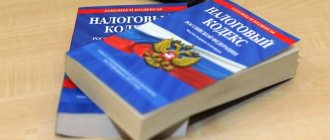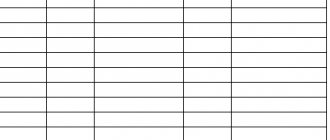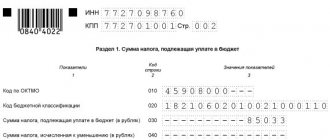Home / Labor Law / Payment and Benefits / Compensation
Back
Published: March 10, 2016
Reading time: 10 min
0
3944
So, you have a child, or maybe even two. Did you know that you have the right to deduct your personal income tax every month? This is the standard child tax credit. It is regulated by Article 218 of the Tax Code of the Russian Federation.
It means that every month part of the salary will not be subject to personal income tax, which is 13%.
- Who is eligible for this deduction?
- How to calculate the tax allowance for a child in 2021? An example of calculating START for children in 2015
- An example of calculating START for children in 2016-2017
- Example
Who is eligible for the standard child tax credit in 2021?
Any citizen who (clause 4, clause 1, article 218 of the Tax Code of the Russian Federation) can receive a “children’s” personal income tax deduction in 2021:
- works officially (under an employment contract or GPC agreement);
- has a minor child (children) or a child (children) under the age of 24 years old studying at a university;
- provides for the child(ren), i.e. pays for his food, treatment, education, etc.
Thus, the recipients of the deduction are:
1. natural parents (mother and father): 2. spouses of natural parents (stepfather and stepmother);
Notice! A divorced parent retains the right to receive a “child” deduction, even if he does not live together with his child. The main thing is that he participates in ensuring it. (Letters from the Ministry of Finance of Russia: dated May 22, 2013 No. 03-04-06/18179, dated April 3, 2012 No. 03-04-06/8-96, etc.).
3. adoptive parents (mother and father); 4. spouses of adoptive parents; 5. adoptive parents; 6. guardians; 7. trustees.
Note! Spouses of adoptive parents, guardians and trustees are not entitled to the standard tax deduction for an adopted/guardian/ward child.
The deduction reduces only those incomes of an individual that are taxed at the tax rate in accordance with paragraph 1 of Article 224 of the Tax Code of the Russian Federation - 13% (paragraph 1 of paragraph 3 of Article 210 of the Tax Code of the Russian Federation). For example, in relation to the income of highly qualified foreign non-resident specialists received from work in Russia, starting from the first day of work, a personal income tax rate of 13% is applied. But it was established by a completely different legislative norm - clause 3 of Article 224 of the Tax Code of the Russian Federation. Consequently, such employees will not be able to claim a tax deduction until they become tax residents of the Russian Federation (letter of the Federal Tax Service of Russia dated October 30, 2014 No. BS-3-11/, letter of the Ministry of Finance of Russia dated July 26, 2010 No. 03- 04-08/8-165). The same goes for:
- foreigners and stateless persons recognized as refugees or granted temporary asylum in the Russian Federation;
- crew members of ships flying the State Flag of the Russian Federation;
- etc.
Who provides the standard child tax credit in 2021?
During the year, the “children’s” deduction for personal income tax in 2021 is provided by the tax agent, who is the source of payment of income to an individual (clause 3 of Article 218 of the Tax Code of the Russian Federation). In particular, this may be an employer who pays a salary to an employee for performing work duties. Or the customer under a GPC agreement, who pays remuneration to the contractor - a private individual (not an individual entrepreneur) for the work performed.
If there are several tax agents, then the “physicist” selects one to whom he will claim tax deductions.
At the end of the year, the deduction can be obtained from the tax office at your place of residence (clause 4 of Article 218 of the Tax Code of the Russian Federation).
How to receive (apply for) a standard benefit?
You should not confuse such concepts as payment of benefits and tax deduction , when the latter does not come as a social benefit and does not require mandatory contact with social services and tax authorities, but is issued through a “tax agent,” that is, the employer. If a citizen works part-time in several organizations at once, the deduction is issued for only one of them. But there are cases when you can contact the Federal Tax Service:
- The employer, for whatever reason, did not provide the deduction.
- The property has been sold or leased.
In these cases, you should contact the tax office at the end of the year, and the refund is paid in a lump sum to a bank account after all the necessary checks have been carried out, and may take 3-4 months.
Amounts of standard child tax credits in 2017
The size of the standard tax deduction for a child directly depends on what kind of account he is in the family: first, second, third, etc. The exception is the deductions established for disabled children. Birth order doesn't matter here. The status of the recipient is important: natural parent or adopted. For convenience, all sizes of “children’s” deductions are summarized in a table.
| Who is the deduction for? | Terms of service | Who gets the deduction? | |
| natural parent, natural parent's spouse, adoptive parent | foster parent, spouse of foster parent, guardian, trustee | ||
| First child | Under the age of 18 or a full-time student, graduate student, resident, intern, student, cadet under the age of 24 | 1,400 rub. | |
| Second child | 1,400 rub. | ||
| Third and each subsequent child | 3,000 rub. | ||
| Disabled child | Under 18 years of age | 12,000 rub. | 6,000 rub. |
| Disabled child of group I or II | Full-time student, graduate student, resident, intern, student under the age of 24 | ||
When establishing the amount of the tax deduction due to a taxpayer for a child, the total number of children in his family is taken into account, including:
- children for whom deductions are not provided (letter of the Ministry of Finance of Russia dated April 17, 2014 No. 03-04-05/17619);
- wards of children (letter of the Ministry of Finance of Russia dated 04/03/2012 No. 03-04-06/8-96);
- deceased children (letter of the Ministry of Finance of Russia dated October 09, 2012 No. 03-04-05/8-1162);
- unadopted children of a spouse from another marriage (letter of the Ministry of Finance of Russia dated March 27, 2012 No. 03-04-06/8-329).
Birth order is determined chronologically by date of birth. In this case, the first child is the oldest child.
Example 1. An employee has three children of his own: the first child was born in 1990. (27 years old), second child – born in 1991. (25 years old), third child – born in 2003. (14 years old). Despite the fact that a “physicist” is not entitled to deductions for the first two children, he has the right to receive a deduction in the amount of 3,000 rubles for a 14-year-old child. as the third in a row.
Some tax agents provide citizens with children with disabilities with a summarized tax deduction, which includes:
- deduction for a disabled child;
- standard “children’s” deduction depending on the number and order of birth of children in the family.
Example 2. An employee applied for a standard tax deduction for his own, only disabled child in the family at the age of 10 years. The tax agent provided a deduction in the amount of RUB 13,400, including:
- 12,000 rub. – deduction for a disabled child under 18 years of age;
- 1,400 rub. – deduction for the first child.
Previously, doing this was risky. Indeed, until recently, the Russian Ministry of Finance opposed the summation of standard deductions for a disabled child (letters: dated 03/17/2016 No. 03-04-05/14861, dated 03/15/2016 No. 03-04-05/14141, dated 02/02/2016 No. 03 -04-05/4977, dated 04/18/2013 No. 03-04-05/13403, etc.). Despite the fact that back in 2015, the Supreme Court of the Russian Federation approved this approach (clause 14 of the Review of the practice of courts considering cases related to the application of Chapter 23 of the Tax Code of the Russian Federation, approved by the Presidium of the Supreme Court of the Russian Federation on October 21, 2015).
But now the financial department has changed its point of view and allowed tax agents to add a deduction for a disabled child with the usual “children’s” deduction, the size of which is determined taking into account the order of birth (letter of the Ministry of Finance of Russia dated March 20, 2017 No. 03-04-06/15803 ).
Tuition deduction
Conditions for receiving social benefits for a child’s education:
- the educational institution has an appropriate license.
- payment for tuition from personal funds (when paying with maternity capital, no deduction is provided).
- full-time training (no benefits are available for other forms of training).
Features of receiving a deduction
- refunds are made not only for studying at universities, but also for studying in clubs, sections, courses;
- a deduction can be provided for education received abroad, but only the costs of the educational process itself must be included in the expenses; living expenses and travel to the educational institution are not subject to reimbursement;
- You can return the required deduction only within 3 years from the date of expenses, then the deduction expires;
- Carrying over the balance of unused benefits is not allowed, but the deduction can be issued every year.
Benefit amount
The amount of deduction for training for the year is 50,000 rubles. for each child, while this amount is not included in the total amount of social deductions provided to a citizen (RUB 120,000).
Papers required to receive benefits:
- declaration in form 3-NDFL;
- application for a deduction;
- agreement with the institution that provided educational services;
- child's birth certificate;
- payment documents confirming the expenses incurred.
Double Standard Child Tax Credit for 2017
The standard deduction for a child in 2021 is double (clause 4, clause 1, article 218 of the Tax Code of the Russian Federation):
- single parent (natural or adopted);
- the only adoptive parent;
- sole guardian;
- the sole trustee.
Current legislation does not define the concept of “sole parent”. But in letters dated June 16, 2016 No. 03-04-05/35111, dated July 3, 2013 No. 03-04-05/25442, etc., the Russian Ministry of Finance notes that a parent is recognized as a single parent if the child does not have a second parent , because he:
- died/declared dead;
- declared missing.
The guardian (trustee) is the only one recognized by the guardianship and trusteeship authorities (letter of the Ministry of Finance of Russia dated December 14, 2015 No. 03-04-05/72969). At the same time, even if the parents of the child under guardianship/ward are not deprived of parental rights, this does not in any way affect the amount of the deduction due to the sole guardian/trustee (letter of the Ministry of Finance of Russia dated 02/04/2013 No. 03-04-06/8-32).
Note that a “physician” cannot count on a double deduction as the only parent if the second parent:
- does not pay alimony (letter of the Ministry of Finance of Russia dated June 16, 2016 No. 03-04-05/35111);
- is not married to the first parent;
- deprived of parental rights (letter of the Ministry of Finance of Russia dated 02/01/2016 No. 03-04-05/4293, letter of the Federal Tax Service of Russia dated 09/02/2015 No. BS-3-11/).
The single parent loses the right to a double “children’s” deduction from the month following the month of marriage (clause 4, clause 1, article 218 of the Tax Code of the Russian Federation). After a divorce, the right to a double “children’s” deduction is renewed, but only if the former spouse did not adopt children (letter of the Ministry of Finance of Russia dated April 2, 2012 No. 03-04-05/3-410).
Also, one of the parents can receive a double deduction for a child in 2021 if the other renounces his right to a deduction in his favor. To do this, he must write a corresponding application. This opportunity can be used by natural or adoptive parents, but not by spouses of parents (natural or adopted), adoptive parents, guardians and trustees.
Note! Only those who have income subject to personal income tax at the rate of clause 1 of Article 224 of the Tax Code of the Russian Federation (13%) have the right to refuse a deduction in favor of their spouse. This is what the Russian Ministry of Finance thinks (letters: dated November 27, 2014 No. 03-04-05/60389, dated August 23, 2012 No. 03-04-05/8-997, dated November 30, 2011 No. 03-04- 05/5-968).
If there is no taxable income, then the right to a tax deduction does not arise, therefore the parent has nothing to refuse. Therefore, if the spouse:
- does not work;
- is on maternity leave or maternity leave;
- is registered with the employment center;
- is a non-working pensioner (for example, due to disability),
then you will not be able to transfer your right to a deduction to your second spouse.
Income Limit to Claim the Standard Child Tax Credit in 2021
The 2021 Standard Child Tax Credit is provided monthly during the tax period (year). But only until the month in which the total taxable income of an individual from the beginning of the calendar year does not exceed the limit established by law.
In 2021, this limit is 350,000 rubles. This value should have been maintained last year. But before January 1, 2021, the income limit was 280,000 rubles.
By the way! If the total income of a “physicist” since the beginning of the year has reached 350,000 rubles. (exactly!), then the “children’s” personal income tax deduction in the month when this happened is still provided to him. But starting next month – no.
When calculating the maximum amount of income, only those incomes that are subject to personal income tax at the rate in accordance with clause 1 of Article 224 of the Tax Code of the Russian Federation are taken into account - 13%:
- salary, bonuses, allowances;
- vacation pay, compensation for unused vacation;
- temporary disability benefits;
- remuneration under GPC agreements with an individual - not an individual entrepreneur;
- etc.
Partially exempt payments are included in the calculation only to the taxable extent. Such clarifications are contained in the letter of the Ministry of Finance of Russia dated March 21, 2013 No. 03-04-06/8872. In particular, this applies to financial assistance at the birth (adoption) of a child in excess of 50,000 rubles. (Clause 8 of Article 217 of the Tax Code of the Russian Federation), gifts and material assistance over 4,000 rubles. (Clause 28, Article 217 of the Tax Code of the Russian Federation), etc.
Note! Income received by an individual resident of the Russian Federation in the form of dividends is not taken into account when calculating the income limit for obtaining a child deduction, despite the fact that it is taxed at a rate of 13%. This conclusion follows from paragraph 2, paragraph 3, Article 210 of the Tax Code of the Russian Federation.
As for part-time workers, when determining the right to a “children’s” deduction, the income of such workers should also not exceed the specified limits. At the same time, if the part-time worker is internal, then the income received by him both from his main position and from his combined position is taken into account (clause 4, clause 1, article 218 of the Tax Code of the Russian Federation, clause 2 of article 226 of the Tax Code of the Russian Federation). And if external, then part-time income is not taken into account (clause 3 of article 218 of the Tax Code of the Russian Federation, paragraph 3 of clause 3 of article 226 of the Tax Code of the Russian Federation).
If a citizen has not been employed since the beginning of the calendar year, then when checking the “income” limit (RUB 350,000), it is necessary to take into account the income he received at his previous place of work in the current tax period, if a tax deduction was provided for it (clause 3 of Article 218 Tax Code of the Russian Federation).
Changes in the personal income tax rate
Changes in personal income tax from 2021 have also occurred in relation to the tax rate. Government bodies set out to redistribute the tax burden of citizens. Adjustments are planned according to a progressive scale of tax rates, according to which:
- Individuals with earnings of up to 180,000 rubles per year are exempt from paying personal income tax.
- Citizens with an annual income of up to 2.4 million rubles pay taxes at a rate of 13%.
- Individuals with revenues of up to 100 million rubles per year pay tax at a rate of 30%.
- Citizens with an annual income of 100 million rubles or more pay tax at a rate of 70%.
- Income received from bank deposits is taxed at a rate of 35%.
2021 Standard Child Tax Credit Period
When does the right to deduction arise?
For the first time in 2021, a citizen can apply for a standard “children’s” deduction in the month (clause 4, clause 1, article 218 of the Tax Code of the Russian Federation):
- birth of a child (children);
- adoption of a child (children);
- establishing guardianship (trusteeship);
- entry into force of the agreement on the transfer of the child (children) to be raised in a family.
Example 3: The employee gave birth to a child on October 31, 2021. He is entitled to a tax deduction for the period from October to December 2021.
New spouses of parents with children are entitled to a deduction from the month of marriage.
Example 4. An employee married a man with a child from her first marriage in August 2021. She has the right to receive a tax deduction for this child for the period from August to December 2016.
A guardian/trustee can apply for a deduction starting from the month in which guardianship/trusteeship of the child was established.
When the right to deduction is lost
The taxpayer loses the right to the standard “children’s” deduction from the next year if in the current year (clause 4, clause 1, article 217 of the Tax Code of the Russian Federation):
- the child(ren) have reached 18 years of age;
- the agreement on the transfer of the child (children) to be raised in a family has expired or been terminated early;
- the child died.
For a tax deduction for a full-time student (graduate student, resident, etc.) under the age of 24, clause 4, clause 1, article 217 of the Tax Code of the Russian Federation, different rules are established. The deduction is valid only until the month in which:
- <or> the child has turned 24 years old, even if his education has not yet ended (letter of the Ministry of Finance of Russia dated October 22, 2014 No. 03-04-05/53291);
- <or> the child’s education has ended, even if he has not yet turned 24 years old (letter of the Ministry of Finance of Russia dated November 6, 2012 No. 03-04-05/8-1251).
As for guardians and trustees, to answer the question of when they lose the right to a “children’s” deduction, you need to turn to the norms of the Family and Civil Code.
In accordance with paragraph 2 of Article 145 of the RF IC, guardianship is established over children under the age of 14 years. Once the child reaches the specified age, the guardian automatically becomes a trustee (Clause 2 of Article 40 of the Civil Code of the Russian Federation). Guardianship continues until the ward turns 18 years old, or gets married, or otherwise acquires full legal capacity (Clause 3 of Article 40 of the Civil Code of the Russian Federation). Therefore, starting from the year following the year in which the child reached the age of majority, a taxpayer who has lost the status of a trustee can no longer use the deduction (letter of the Ministry of Finance of Russia dated October 25, 2013 No. 03-04-05/45277).
A single parent does not have the right to receive a double deduction for a child (children) starting from the month of marriage.
The “children’s” deduction is no longer provided to an individual if his taxable income since the beginning of the year has exceeded 350,000 rubles.
The parent whose child got married is also not entitled to a deduction. At least, this is what the Russian Ministry of Finance thinks (letters: dated 03/17/2016 No. 03-04-05/14853, dated 03/31/2014 No. 03-04-06/14217).
Procedure for providing standard child tax credits in 2021
To receive a standard “children’s” personal income tax deduction in 2021, a citizen contacts a tax agent (clause 3 of Article 218 of the Tax Code of the Russian Federation):
- with a written statement;
- with documents confirming the right to deduction.
The application is written in free form or on a form developed by the tax agent. Moreover, it is enough to submit it once. There is no need to do this every year. A new application will be needed only when an individual’s circumstances affecting the amount of the deduction change (letters from the Ministry of Finance of Russia: dated 02/26/2013 No. 03-04-05/8-131, dated 08/08/2011 No. 03-04-05 /1-551).
In this regard, when writing, we recommend that you do not indicate the year for which you need to provide a deduction and the amount of the deduction.
Deduction for treatment
Conditions for receiving a deduction for treatment:
- whether the medical institution has an appropriate license;
- provision of services only in medical institutions on the territory of the Russian Federation;
- inclusion of medical services provided and purchased drugs in the list approved by the Government of the Russian Federation;
- the deduction can be paid only within three years from the date of expenses for the purchase of medicines or the provision of medical services;
- The benefit is multi-use and can be claimed every year within the established limit.
Deduction amount
For regular treatment, the deduction amount is 120,000 rubles.
In this case, this amount is included in the total amount of all social deductions (for one’s own treatment and education).
For expensive treatment, the benefit amount is unlimited and is provided in the full amount of costs incurred.
Papers required to receive benefits:
- reporting in form 3-NDFL
- agreement on the provision of medical services;
- certificate of payment for medical services, which indicates the code of proven medical services;
- prescription form (if medications were purchased);
- payment documents;
- child's birth certificate;
- tax refund application.
Documents to confirm eligibility for the standard child tax credit in 2021
The most important document that will be required from the applicant for the “children’s” deduction in any case is a copy of the child’s birth certificate. If there are several children in the family, then this document must be submitted for each child, even if some of them are not entitled to a deduction.
The table below lists other documents required to confirm an individual's right to a tax deduction, depending on a particular situation.
| Situation | Documentation |
| The deduction is issued for a child aged 18 to 24 years | 1) Certificate from the educational institution (educational institution) where the child is studying (submitted annually); 2) Translation of a certificate from an educational institution (school) into Russian if the child is studying abroad |
| The deduction is issued for a disabled child | Copy of ITU (VTEK) certificate confirming disability |
| The deduction is made by the adoptive parent | 1) A copy of the agreement on the transfer of the child (children) to be raised in a family; 2) Copy of the adoptive parent’s ID |
| The deduction is made by the spouse of the child’s parent | 1) A copy of the marriage registration certificate; 2) Statement by the parent that the spouse lives with the child and participates in providing for him/her |
| The deduction is drawn up by the adoptive parent | Certificate of adoption or certificate of adoption |
| The deduction is drawn up by the guardian/trustee | Documents from the guardianship and trusteeship authorities confirming the establishment of guardianship or trusteeship (for example, an extract from the decision to establish guardianship or a guardianship agreement, etc.) |
| The deduction is issued by the father who is not in a registered marriage with the child’s mother (civil marriage) | 1) Certificate of paternity (if information about the child’s father is not indicated in the birth certificate); 2) A written statement from the mother that the child’s father lives with him and (or) participates in his support. In the absence of this confirmation, a certificate of joint residence with the child is submitted. |
| The deduction is issued by a divorced parent who does not live with the child | 1) <or> A written statement from the ex-spouse that the parent applying for the deduction is involved in providing for the child (if the latter financially supports the child on the basis of an oral agreement with the ex-spouse)); 2) <or> A copy of the agreement on payment of alimony or a writ of execution (court decision) on the transfer of alimony for child support in favor of the other parent; |
| The deduction is made by the only parent | A document certifying that the parent is not married (passport), as well as: 1) <or> Death certificate of the other parent; 2) <or> Certificate from the registry office in form No. 25, which indicates that the entry about the child’s father in the birth certificate was made according to the mother’s words; 3) <or> Child’s birth certificate, in which there is a dash in the “Father” column; 4) <or> Extract from the court decision declaring the other parent missing |
| The deduction is drawn up by the sole guardian/trustee | Act of the guardianship (trusteeship) authority on the appointment of a guardian (trustee) |
| The deduction is issued by the parent in double amount due to the refusal of the second parent to receive the deduction. | 1) Application from the second parent to refuse to receive the deduction; 2) Certificate 2-NDFL from the place of work of the second parent (submitted monthly) |
| The deduction is issued by an individual who has not been employed since the beginning of the year | 1) <or> Certificate 2 - Personal Income Tax for the current year from the previous place of work; 2) <or> Statement of lack of income and a copy of the work book from which it follows that from the beginning of the tax period until the moment of employment the “physicist” did not work |
Documents for registration
To receive compensation, you must provide the following package of documents:
- Birth certificate for all children.
- Medical certificate of disability.
- Certificate of full-time study.
- Marriage certificate.
Additionally, in the case of a single parent or guardian, the following are provided:
- Death certificate or missing parent certificate.
- Certificate No. 25 about the situation of a single mother.
- Confirmation that the parent is not remarried.
2017 Standard Child Tax Credit Codes
At the end of each year, all tax agents for personal income tax report to the Federal Tax Service on the income received from them by taxpayers and on the amounts of tax withheld from this income. For this purpose, a certificate is provided in form 2-NDFL (approved by Order of the Federal Tax Service of Russia dated October 30, 2015 No. ММВ-7-11/).
This certificate is generated separately for each individual. In the document, in addition to data on income and personal income tax, the tax agent reflects information about deductions provided to the taxpayer, including for a child (section 4 of the 2-NDFL certificate). These deductions are designated by special codes approved by Order of the Federal Tax Service of Russia dated September 10, 2015 No. ММВ-7-11/.
Last year, changes were made to the current deduction codes (Order of the Federal Tax Service of Russia dated November 22, 2016 No. ММВ-7-11/). So, in particular, all standard child tax deduction codes 114-125 were replaced with new codes 126-145. In addition, there are more of them. Now the deduction code also depends on who it is provided to: the natural parent (spouse of the natural parent, adoptive parent) or the adoptive parent (spouse of the adoptive parent, guardian, trustee).
The updated codes for “children’s” deductions have been in effect since December 26, 2016. Therefore, when preparing 2-NDFL certificates for 2021, tax agents are required to use them.
All new standard child tax credit codes for 2017 are reflected in the table below.
| Deduction for a child under the age of 18, as well as for a full-time student (graduate student, resident, etc.) under the age of 24 to the parent, spouse of the parent, adoptive parent , who is supporting the child | |
| 126 | when provided for the first child |
| 127 | when provided for a second child |
| 128 | when provided for the third and each subsequent child |
| 129 | when provided for a disabled child under the age of 18 years or a disabled child of group I or II aged from 18 to 24 years |
| Deduction for a child under the age of 18, as well as for a full-time student (graduate student, resident, etc.) under the age of 24 for a guardian, trustee, foster parent, spouse of a foster parent who is supporting the child | |
| 130 | when provided for the first child |
| 131 | when provided for a second child |
| 132 | when provided for the third and each subsequent child |
| 133 | when provided for a disabled child under the age of 18 years or a disabled child of group I or II aged from 18 to 24 years |
| Double deduction for a child under the age of 18, as well as for a full-time student (graduate student, resident, etc.) under the age of 24 to a single parent, adoptive parent | |
| 134 | when provided for the first child |
| 136 | when provided for a second child |
| 138 | when provided for the third and each subsequent child |
| 140 | when provided for a disabled child under the age of 18 years or a disabled child of group I or II aged from 18 to 24 years |
| Double deduction for a child under the age of 18, as well as for a full-time student (graduate student, resident, etc.) under the age of 24 for the sole guardian, trustee, foster parent | |
| 135 | when provided for the first child |
| 137 | when provided for a second child |
| 139 | when provided for the third and each subsequent child |
| 141 | when provided for a disabled child under the age of 18 years or a disabled child of group I or II aged from 18 to 24 years |
| Double deduction for a child under the age of 18, as well as for a full-time student (graduate student, resident, etc.) under the age of 24 for one of the natural parents, if the other parent refused the deduction | |
| 142 | when provided for the first child |
| 144 | when provided for a second child |
| 146 | when provided for the third and each subsequent child |
| 148 | when provided for a disabled child under the age of 18 years or a disabled child of group I or II aged from 18 to 24 years |
| A double for a child under the age of 18, as well as for a full-time student (graduate student, resident, etc.) under the age of 24 for one of the adoptive parents, if the other adoptive parent refused the deduction | |
| 143 | when provided for the first child |
| 145 | when provided for a second child |
| 147 | when provided for the third and each subsequent child |
| 149 | when provided for a disabled child under the age of 18 years or a disabled child of group I or II aged from 18 to 24 years |
Sample application
Click to enlarge the image
In addition to the existing package of documents, you must write an application addressed to the head of the enterprise, a template for which is available in the human resources department of any organization. The application form can be filled out online on the website or downloaded to your computer. If the deduction is issued through the Federal Tax Service, then you need to submit a 3rd personal income tax declaration for the year of the proposed benefit, take a certificate of income 2nd personal income tax, provide a bank account and a copy of the first two pages of the passport to the existing package of documents.
Help 2 personal income tax
1 file(s) 42.50 KB
Declaration 3 personal income tax
1 file(s) 975.74 KB






